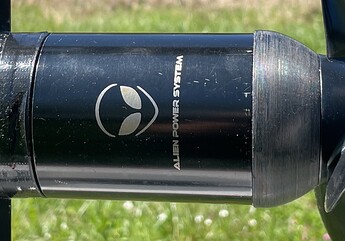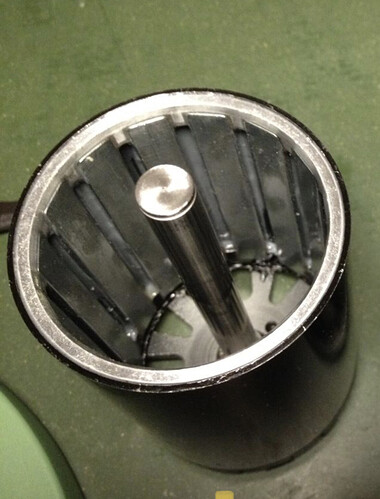I don’t know really. If using fluid for cooling, would assume that there will be some wear and tear on the insulation of the windings also, its a lot of rpm during one hour usage ? I also understood that part of the idea of using epoxy is to smooth the surface so the fluid in the motor will add less resistance( the efficiency loss can be relative big due to the fluid inside). But on the other hand, if both stator and rotor are made smooth with epoxy, also cooling effect will probably be less(small amount of fluid due to small available space)?
Hydraulic losses I think they call it, by epoxying the stator + rotor you basically create two cylinders one smoothly spins around the other and doesn’t pump as much water.
Epoxying is also done to keep the windings tuck in place, if a single strand of copper loosen up, more will follow, if they get caught in the spinning rotor and insulation breaks, your motor will die and your entire system is at risk of shorting out and catch fire, not fun at all.
@XSailor just throw some epoxy on it, stop overthinking.
Can you guys tell me what a save max motor current is for an 63100 outrunner.
FreeRCHobby claims 100 A.
Is 100 A save for the motor or should I be worried of burning it out?
No need to worry, 63100 is proven to work, while submerged underwater cooling is very efficient, the claimed max 100A is in air, it’s all about temperatures,
In water you can pull 120A (peaks) or even more, plus, if you get a Vesc you can limit the motor current to what ever value you want.
It doesn’t require so much current to foil, you need around 80~100A 3000~4000w (usually, only few seconds) to pop out of the water, cruising 30~50A, don’t worry 
Thanks, I wasn’t sure and didn’t want to ruin my motor testing out the limits.
But you are right, while submerged it shoudn’t get too warm and burn out.
Run it on 150A motor current max setting in vesc. No problem at all. Max battery is set to 100A.
@sat_be Hi sat, I see the term duty-cycle all the time over the forum, but it’s something that doesn’t make sense to me, is it related to throttle?
Like, if you cruise at half throttle say 40A Batt amps, does it mean that the whole time the motor current is at 80A?
More or yes, it‘s a bit more complicated, see here: Battery Amps, Motor Amps and Duty Cycle... Please Explain - #4 by professor_shartsis - esk8.news: DIY Electric Skateboard Forums
Duty cycle is related to bldc mode, so 100% throttle means 100% Duty cycle (95% with vesc in FOC mode).
With vesc you can also run FOC mode which is smoother and allows for current control instead of duty cycle. You adjust the curren with is proportional to torque.
The duty cycle influences the motor phase current only indirectly. The duty cycle determines the voltage the motor gets and thereby the maximum RPM it can deliver. The motor (phase) current is mainly a function of the load, the RPM and the applied voltage. As it is much harder to control the load in a vehicle like a skateboard or boat with efficient propeller with low slip, it is an elegant way to limit the phase current. With air propellers it is much easier to limit the motor current by voltage as there is a lot of slip.
The phase current determines the field strength and the maximum (useful) field strength is limited by the construction of a motor. This said i recommend to use around 130A phase current for the 130-140 Kv 63100 from my own experience. 150A might be ok as well, but not more. The efficiency sinks by the stray field.
I recommend not to use a thick coating on the windings, otherwise the cooling of the windings can get worse than unprotected in air. I did this once and the motor was cooking pretty soon and the winding was damaged.
I apply a very thin coating to all of my stators including winding and no one burned while using different VESCs with phase current limit. If this is best done with epoxy, PU, or other stuff, i do not know, i use epoxy with low viscosity under vacuum , but maybe it is overengineered. At least none of my stators was damaged by rust so far so it seems to be a reliable solution.
To manage the friction i coat the magnets with epoxy and lathe it, so the inner structure of the rotor is round and smooth.
Thanks for your comments. Regarding filling the gaps between the magnets, most seams to do this with plain epoxy or in combination with a filler. Adding aluminum powder to epoxy improves the heat conductivity. What do You think, would aluminum powder mixed with the epoxy interfere with the function of the magnets/field disturbing the motor function?
The improvement in heat conductivity is very low compared to the effect of water exchange. Make or leave some small holes in the aluminum end bell to enable exchange so it is no dead end.
That is for sure, but is not the amount of fluid that can circulate inside when gap is filled very small( not much space at all)? So maybe it would not hurt if little improved cooling through the bell also? I mean, when putting the epoxy there, mixing aluminum powder to it is not adding to the work that much. Found a study where epoxy rather low original conductivity of about 0,67 W/m. K was improved to 1,46 when added 45 % aluminum powder to the mixture. Does this have any real impact don’t know… Would You think this have any adverse effects?
1,46W/m is still a thermal isolator.
Ok, so filling the space between the magnets reduce the cooling through the outside of the bell, but on the other hand reduce friction so inside/stator will remain cooler, good fluid flow required in any case.
It is no problem with the bell closed, I run it like this for quite some time. The slots at the end of the bell are covered with a prop adapter, the slots at the stator are covered with duct tape. It is enough for cooling if the water enters the gap between stator and rotor.
Our motor’s windings are never 100% coated/insulated, any conductive material added to the epoxy mix will greatly increase the risk of your windings shorting out.
That’s a good point(and one of the reason asking here, always get goo replies)!
No, just closed the slots at the end of the bell (to keep the epoxy inside) and poured some epoxy in. Turned the bell in an abgle to wet the whole surface and turned around to release the excess epoxy. Had to remove some thicker drops that set at the brim. Did not fill the slots.
OK, thanks for info/picture. Interesting, difficult to judge as so many factors, but you get away with a limited fluid flow inside the motor, wonder would the fact that you did not fill the gap contribute to this(better cooling)?

